Queer Illustrations: Judging a Book by its Cover
Curatorial Statement
This exhibit’s purpose is to compare and contrast the visual differences between Alyson Books and their more heteronormative counterparts. Throughout our research over the course of the semester and in examining many of the texts produced by Alyson Books, we found illustrative and visually representative patterns among many of their texts that we deemed worthy of greater analysis. Using our prior knowledge about heteronormative texts, we created case studies to analyze the possible intentions behind and contexts of various cover images, comparing a heteronormative book to an Alyson Book through side-by-side analysis. By doing so, we wanted to discover historical and ongoing stereotypes, cliches, and beliefs that were produced by publications (whether intentional or unintentional), further exploring why visual differences exist and what goal they accomplish both historically and culturally. This exhibit was created through our "Humanities Startup" course at Davidson College in the spring of 2024, with the exhibit being our final project.
My First Time: Gay Men Describe Their First Same-Sex Experience vs The First Time: True Tales of Virginity Lost & Found
Chinedu Okeke
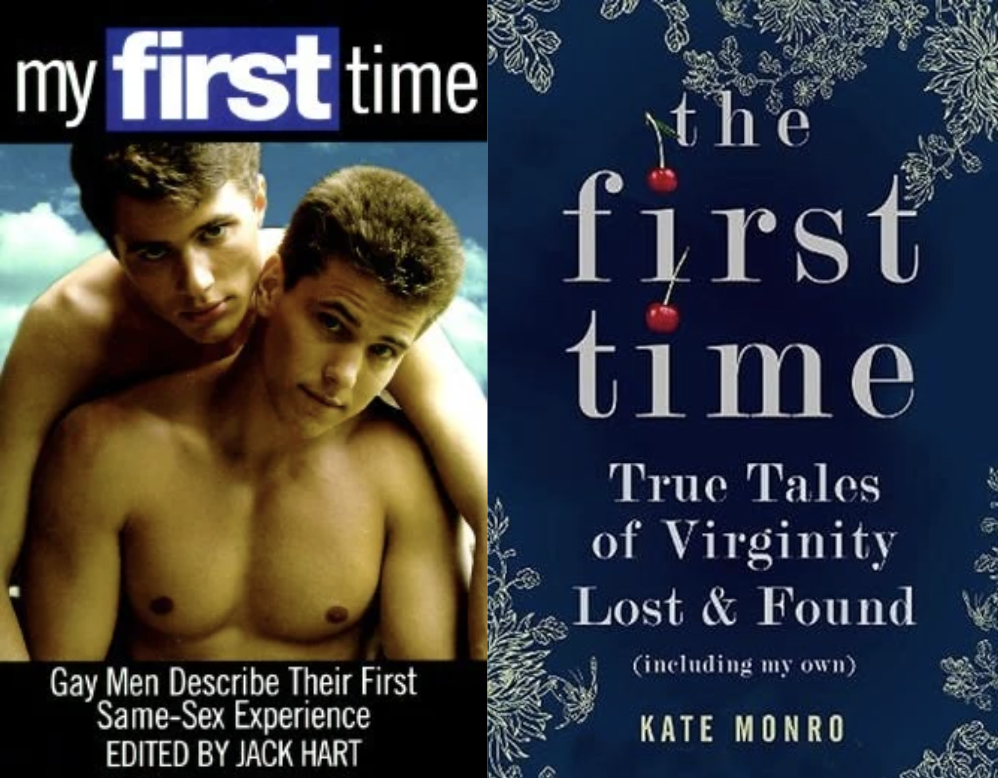
It only takes a quick glance for one to figure out what both of these texts are about. Both detail the experiences of people losing their virginity, looking at a multitude of different perspectives and people. The main difference between the two books is that Jack Hart’s version focuses on the perspective of gay men and their first time having same-sex sex while Kate Monro’s version has a broader scope and includes an array of different individuals and relationships while nevertheless focusing on heterosexual pairings.
Reviews of both books that we have seen have been relatively positive. Monro’s book is highly praised for its multiple perspectives, that are all informative and captivating, while also showing the true highs and lows of these kinds of situations. Many of the reviews seens on GoodReads and Amazon followed a similar pattern for Hart’s version, as many readers appreciated getting to see an insight into other people’s first time and brought them back to their first time.
Taking this information into account, it is interesting that despite the stark similarities in material, there is a drastic contrast between the two cover choices for both books. In Hart's book we see a display of two shirtless men, within close proximity of one another, staring back at the reader. Monro’s book, however, which has a lot more heteronormative perspectives, features a blue background with the title and author's name featured on top. The only real “eye catching” features are the small flowers embroidered around the edges of the cover and the two cherries taking the place of the dots on the i’s within the title.
The contrast between these different covers might not seem significant at first glance, but they both follow typical trends that we have seen when looking at queer book covers vs. heteronormative covers. For many heteronormative books, especially those that delve into sexual or sexually adjacent themes, the covers tend to be relatively straightforward and usually are not too provocative. And typically when they do, they tend to be in the form of innuendos. Looking back at Monro’s cover, we see the specific use of cherries and flowers. The cherries can be a reference to the term “popping your cherry,” referring to someone, usually a woman, losing their virginity. While the flowers are likely referring to the “deflowering,” which typically refers to one having their virginity taken.
On the other hand, queerer texts tend to feature more erotic displays in comparison to their heteronormative counterparts. They seem to fall in line with the common stereotype of “flashiness” that is usually associated with the LGBTQ community. So it is not too much of a surprise that Hart’s book, along with some of the others featured in our collection, that the cover is very attention grabbing and blatantly sexual in nature. In fact, it seems that many of these covers may be unintentionally reinforcing the portrayals of the community in media that we saw in the past, as many of them featured heavily on promiscuous and flamboyant undertones, with heavy emphasis on their “differentness” in comparison to heterosexuals.
Archie vs Dykes to Watch Out For
Chinedu Okeke
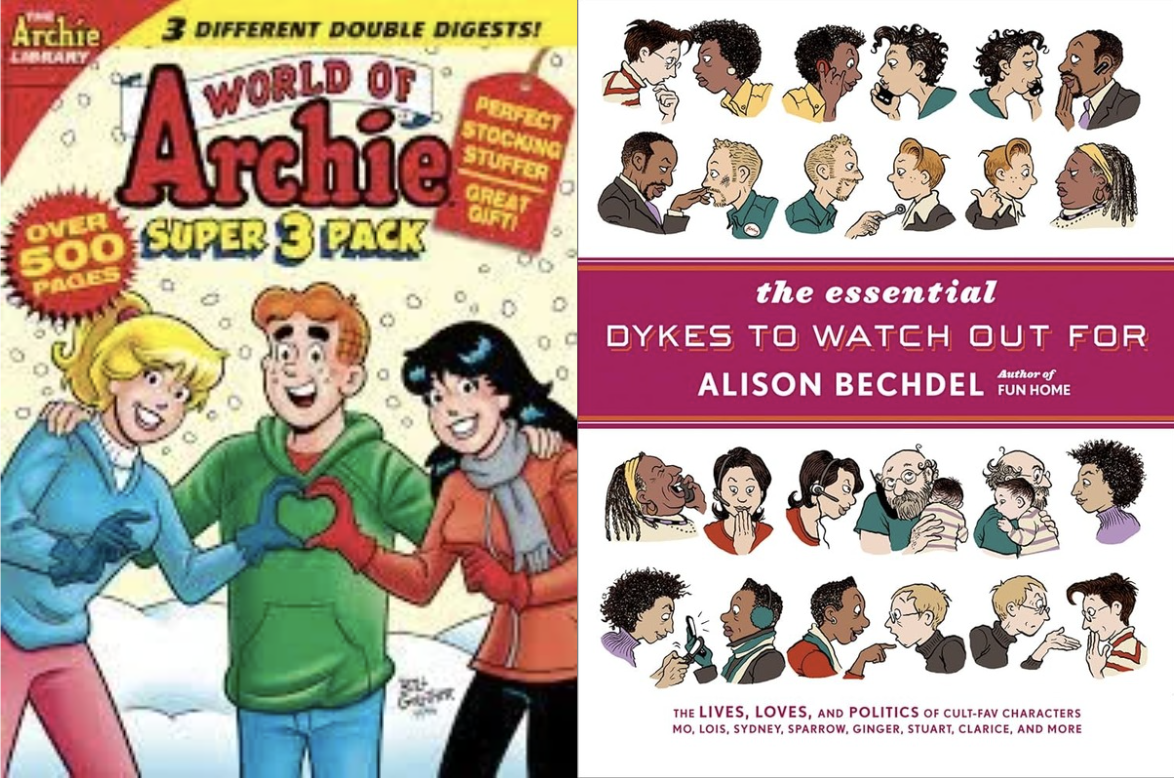
Archie is a comic series, written and drawn by Bob Montana and John L. Goldwater, primarily revolving around the lives of Archie Andrews and his friends in the fictional town of Riverdale. The stories typically focus on the humorous and often romantic adventures of Archie, Betty, Veronica, Jughead, and other characters from Riverdale High School. The comic primarily focuses on topics related to friendship, teenage life, school, and romance, often with a lighthearted and comedic tone. Archie comics are known for their iconic characters, witty dialogue, and timeless appeal to readers of all ages. The comic was published and released by M.L.J. Magazines, Inc, later becoming Archie Comics Publications, Inc. The comics received so much public recognition that they even received its own spinoff television show called Riverdale, which first began airing in 2016 on the CW network.
Dykes to Watch Out For is a comic series, created by Alison Bechdel, that centers around the lives and relationships of a diverse group of lesbian and queer characters. The series explores various aspects of LGBTQ+ life, including activism, politics, relationships, and identity. The comic strip follows the day-to-day experiences of its characters as they navigate the complexities of love, work, and friendship. Dykes to Watch Out For is known for its humor, social commentary, and portrayal of realistic LGBTQ+ characters and relationships. The comic has been revered as one of the first groundbreaking works of fiction to give appropriate context, depiction, and commentary on the LGBTQ community. The comic has produced a multitude of strips and has been in circulation since 1983. It has been picked up by many LGBTQ newpapers, with the Washington Blade being the most notable.
Looking at the art and the strips themselves, besides the actual art styles themselves differing, there are a few contrasting differences that can be spotted. With Archie, there is a much more light hearted vibe to the stories. It seems as though the story itself is taking itself too seriously and does not cover many difficult topics. The strips feature many vibrant colors, characters typically seem happy, and much of the settings themselves seem to be lively. At the same time, Dykes to Watch Out For, seems to be a bit more gritty. This could be due to most of the featured strips being in black and white, but much of the art seems to have darker undertones while also having more realistic portrayals of characters and settings. This feeds into the overall goals of the comic, as Bechdel’s aim was to give an accurate portrayal of daily queer life, while Archie seems to be a more whimsical and exaggerated rendition of teenage life.
Despite both comics having the same general themes on the surface, the comics are pretty different and are meant for different audiences. Due to the lighthearted nature of Archie, anyone from children to grown adults can indulge in its content with little concern. Bechdel’s work, although also focusing on teenage life, covers more critical topics, while having a more LGBTQ focus. So much of the audience tends to include older individuals with many of them being queer and gay. Despite the differing approach to highlight similar surface level topics, both still received high acclaim in their fields as seen by their long runtime.
Born in the 1960s, Alison Bechdel had always had an artistic touch from a young age and was always interested in books. She came from a respectable family, two brothers and a mother and father who both taught at a local school. Everything seemed fine on the surface, but things eventually would take a dark turn when she went off to college. While there she had finally gained the confidence to come out to her parents. She received differing reactions from both her parents, but that would eventually be the least of her issues. Hearing that his daughter was gay, Bechdel’s father gained the confidence to also come out to his wife and family. Unfortunately this led to an immediate divorce, as Bechdel’s mother was not too pleased about the news. Shortly after, her father would be involved in a car accident. However to this day the family and other loved ones do not know if it was truly an accident. With this background it is not surprising that Bechdel went on to not only make LGBTQ related literature, but also made sure to tackle and depict nuanced topics surrounding the community.
It would also be remiss of me if I didn't mention that much of the newer Archie content has made an attempt to cover touchier topics and take on a different undertone. This can be seen especially in the show Riverdale, as the show has attempted to show a much more diverse cast of characters, including those of the LGBTQ community. But similar to many works in the past and even in the present day, the attempt to be inclusive seemed forced as many of the characters only provided shock value, had no deeper nuance, and embodied many of the negative stereotypes surrounding the community.
Chin's Citations
“Alison Bechdel.” Encyclopedia.com, April 2024. https://www.encyclopedia.com/journals/culture-magazines/bechdel-alison.
Archie Comics. Accessed April 22, 2024. https://archiecomics.com/.
Carpenter, Laura M. “Review: The First Time: True Tales of Virginity Lost and Found (Including My Own), by Kate Monro.” Journal of Popular Romance Studies, April 30, 2012. https://www.jprstudies.org/2012/04/review-the-first-time-true-tales-of-virginity-lost-and-found-including-my-own-by-kate-monro/.
“Dykes to Watch out For.” Dykes to Watch Out For RSS. Accessed April 22, 2024. https://dykestowatchoutfor.com/.
Hart, Jack. My First Time: Gay Men Describe Their First Same-Sex Experience. Boston , Massachusetts: Alyson Publications, 1995.
McElhatton, Greg. “Essential Dykes to Watch out For.” Read About Comics, June 10, 2009. https://readaboutcomics.com/2009/06/10/essential-dykes-to-watch-out-for/.
Monro, Kate. The First Time: True Tales of Virginity Lost and Found (Including My Own). Icon Books, 2011.
“My First Time: Gay Men Describe Their First Same-Sex Experiences.” Goodreads. Accessed April 20, 2024. https://www.goodreads.com/en/book/show/1038076.
Powers, Stella. “The Good and the Ugly of LGBTQ+ Representation in Film and Television.” The Miami Student, November 30, 2023. https://www.miamistudent.net/article/2023/11/lgbtq-representation-film-tv-movies.
Heather Has Two Mommies: 1st Edition vs 2nd Edition
Emma Buehrer
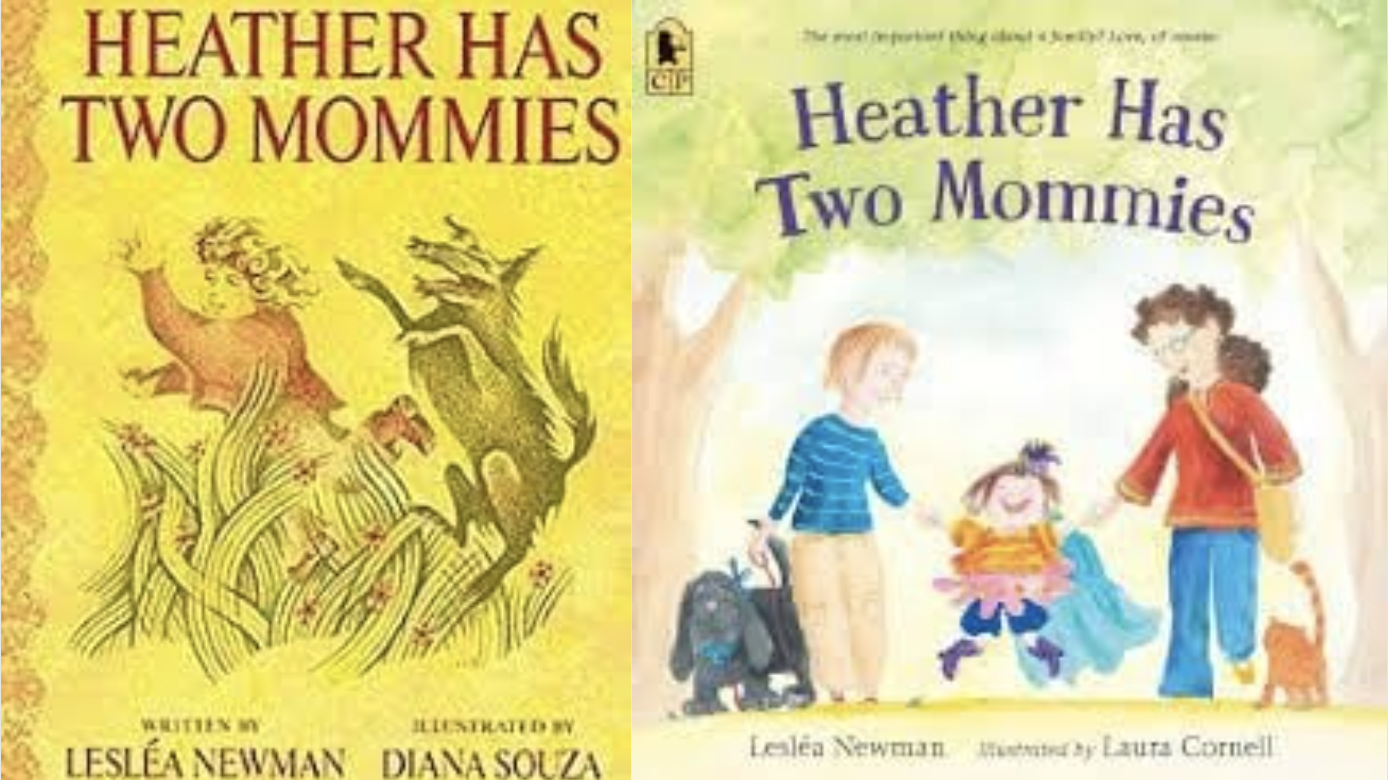
Heather Has Two Mommies by Leslea Newman is a children’s book that details the life of Heather, a young girl whose favorite color is two. She has two of many things, but most significantly, Heather has two mommies. Heather’s mommies explain how they had Heather and made a family. When Heather goes to school, she has to explain to a classmate that she does not have a daddy like the other children. However, when the class draws their families, Heather realizes that each family is different, and that’s okay.
The 9th most challenged book of the 1990s, Heather Has Two Mommies caused a wave of polarization, book banning, and public debate. According to a 1992 USA Today Op-Ed, the book was a part of a “militant agenda” to “present sodomy and lesbianism as normal alternative lifestyles.” The author, Newman, received 50 rejections before finding a publisher. Today, however, there is a massive shift in the book’s reception; the Amazon book listing features 814 reviews that average to 4.9/5 stars; only 1% of the reviews were 1 star, but they typically expressed the rage towards the queer representation that was so common upon the book’s initial publishing, quoting religion and traditional values to explain their disgust.
Heather Has Two Mommies features two distinctly different covers that signify very different moments in politics and queer history. The first edition, released in 1989, showcases on the cover a young blonde girl playing with her dog, accessorized by an ornate orange binding. The drawing style is significant; the style looks vintage compared to modern children’s illustrations, but it was a vintage style even in the 1980s. In fact, Heather Has Two Mommies most resembles the illustration styles popular for childrens’ books in the 1950s and 60s (examples included below), and even the typography seems to reference a style of the past. The ornate binding design has a similar effect to the classic and popular Little Golden Book bindings. Choosing to lean into a traditional style indicates ideas of safety and nostalgia for viewers, encouraging the idea that the book has already been accepted and celebrated for years. This was a significant choice in 1989; far before gay marriage was legalized, the cover design’s implications of familiarity may have allowed the book to proliferate among more bookstores and schools before it was ultimately banned. The 2015 revival edition of Heather Has Two Mommies, on the other hand, is a distinctly modern update; the cartoon-esque design style is indistinguishable from the innumerable cartoon-esque colorful childrens’ books in print today, and the family structure is openly depicted on the front cover, offering unabashed representation of queer families. Released only three months before gay marriage was legalized in all states on June 26, 2015, the cover of the second edition is transparently political, unabashedly portraying a happy queer family. This shift aligns with the rapidly growing political movements in which the queer community insisted that they deserved to be out and proud. It was now more important to bring attention to the book because of its queerness, rather than hiding the queer storyline beneath the surface. Queer writer Alyssa Lizarraga, in her article on queer book covers, writes “The signaling is effective, and I am much more likely to pick up the book that seems to say: “I see you, I am you, and these pages will keep you safe.”
Leslea Newman stated that she wrote the book after a lesbian mother expressed to her that there were no books that represented her family. In the 1980s and '90s, gay partnership, marriage, and parenting was hardly recognized, and rarely accepted; it was not until 2000 that Vermont legalized civil unions between same-sex couples, and only in 2015 was gay marriage was legalized nationwide. Notably, gay parenting and adoption followed a different timeline. The Sperm Bank of California, opened in 1981, was the first sperm bank to intentionally offer fertility services to single and lesbian women. New Jersey was the first state to legalize same-sex-couple adoption in 1997, and Florida was the last state, only legalizing adoption in 2010. The significance and cultural impact of Heather Has Two Mommies is exacerbated by the fact that it was released far ahead of legislative recognition of queer families.
The Essential Guide to Lesbian Pregnancy, Conception, & Birth vs What to Expect When You're Expecting
Emma Buehrer

The Essential Guide to Lesbian Conception, Pregnancy, and Birth fulfills the expectations set by its title, and discusses at length topics concerning pregnancy and birth that may specifically pertain to lesbians. Topics include fertility centers and treatments, legal forms and contracts, midwifery, sperm donor options and processes, nutritional guides, and coparenting. It has two editions: one published in 2002, and the second updated in 2006. The book shares information that could pertain to anyone going through a pregnancy with a form of artificial insemination, and gives relevant advice from fertility treatments through delivery to empower lesbian families. What to Expect When You’re Expecting is a cultural phenomenon; widely known and a bestseller, the book similarly covers topics such as sex and fertility, proper nutrition, advice on nausea and other common pregnancy symptoms, going into labor, advice for dads, and even advising on gender reveal parties and beauty during pregnancy. It features 5 editions; the original What to Expect was first published in 1969, and the most recent edition currently sold was published in 2016.
Immediate glances at The Essential Guide to Lesbian Conception and What to Expect When You’re Expecting reveal drastically different design choices and priorities. What to Expect When You’re Expecting is unique in its symbolism of what a mother and motherhood looks like, even just from the cover. While many heteronormative books only allude to their normativity and do not need to show gendered symbols to convince the audience, What to Expect draws on the most traditional tropes on the cover. The background of a homemade quilt evokes ideas of the mother as a traditional homemaker and nurturer, affirming the image of the mother who sews and crafts homemade necessities to give to her children, tasks which can only be accomplished by staying home. The woman on the cover is white, thin, trendy, and distinctly modest, smiling warmly at readers. She is a representation of the perfect American mother: youthful and beautiful, unaffected by her own pregnancy, and stylish without implying vanity or overt sexuality. The Essential Guide to Lesbian Conception, Pregnancy, and Birth contrasts strikingly; the blurred body in the background alone departs from normative visual indicators of pregnancy; pregnant women are rarely depicted in the nude, lest the audience come to terms with the fact that the pregnancy connects somehow to sexuality. The body on the cover offers permission and acceptance to lesbian pregnant women by portraying the most bold version of them. The blurred body could be a white woman, but it is not entirely clear due to the oversaturation of the photo. In this way, the body could be almost any woman, inviting all women to engage with the content. Consistent with analyses from The Look of the Book, these two covers signify distinctly “the connection between an individual author’s vision and the social, cultural, and historical circumstances of the time.” (Mendelsund and Alworth, 55).
Reviews and reception of The Essential Guide to Lesbian Conception, Pregnancy, and Birth vary significantly. On Amazon, the book receives 4.3/5 stars, with 18 five star reviews. However, views differ across websites; with a 3.96/5 rating on Goodreads (as of April 25, 2024), many women find the text to be outdated and overly skeptical of medicine. One woman quotes that it was “hard to take the book seriously when it was legitimizing the "intuition" of many of their clients based on absolutely no scientific information” (Goodreads). Still, many other reviewers responded well to the book; 36% of readers left a 5 star review, praising the wisdom of the author and the book’s empowerment of lesbian families. What to Expect When You’re Expecting has an overwhelming amount of positive reviews on Amazon; almost 25,000 readers left a 5 star review and many claimed it was essential to their pregnancy. Again, cross referencing on Goodreads, the reviews shifted significantly; though almost 57,000 readers reviewed the text on Goodreads, it only has 3.8/5 stars (as of April 25, 2024). Some reviewers claim the medical information is outdated, and others insist the amount of information and in-depth descriptions of pregnancy complications were agitating to read through. Many reviewers specifically critique the diet-related information for being outdated and inaccurate. However, 31% of readers still left a 5 star review.
Despite its normalcy, pregnancies are still stigmatized; pregnant women face certain biases and standards. According to Jeanine Skorinko et. al., who wrote “Overlapping Stigmas of Pregnancy, Motherhood, and Weight: Policy Implications for Employment and Higher Education,” pregnant women are “inappropriately touched, less likely to be hired or promoted, paid less, and subjected to a host of stereotypes.” By presenting pregnancy as normal and transparently discussing all aspects of the process of conceiving, being pregnant, and delivering, both books offer women acceptance, affirmation, and safety. Queer women are particularly impacted by these stigmas, as they additionally have to navigate homophobia and the push and pull of legislation surrounding the rights of LGBTQIA+ families. As mentioned regarding the historical significance of Heather Has Two Mommies, the first sperm bank targeted towards single and lesbian women opened in California in 1981, and same-sex couple adoption was only legal in all 50 states in 2010. The Essential Guide to Lesbian Conception, Pregnancy, and Birth provides community and validation for a group of women that have historically been ostracized.
Emma's Citations
“12 Books You’ll Remember If You Were a Child in the 1950s.” AbeBooks, 26 Aug. 2021, https://www.abebooks.com/books/features/books-for-1950s-children.shtml.
"Customer Reviews: Heather Has Two Mommies." Amazon. https://www.amazon.com/product-reviews/0763690422/ref=cm_cr_unknown?ie=UTF8&filterByStar=five_star&reviewerType=all_reviews&pageNumber=1#reviews-filter-bar. Accessed 29 Apr. 2024.
"Customer Reviews: The Essential Guide to Lesbian Conception, Pregnancy, and Birth." Amazon. https://www.amazon.com/product-reviews/1555836267/ref=acr_dp_hist_5?ie=UTF8&filterByStar=five_star&reviewerType=all_reviews#reviews-filter-bar. Accessed 29 Apr. 2024.
Fairyington, Stephanie. "‘Heather Has Two Mommies’ Is Still Relevant 30 Years Later." The New York Times. 17 Apr. 2020, https://www.nytimes.com/2020/04/17/parenting/heather-two-mommies.html.
Lizarraga, Alyssa. “I Judge Books by Their Covers and You Should Too.” LatinaMedia.Co, 16 Mar. 2023, https://latinamedia.co/book-covers/.
"Milestones in the American Gay Rights Movement." PBS. https://www.pbs.org/wgbh/americanexperience/features/stonewall-milestones-american-gay-rights-movement/. Accessed 29 Apr. 2024.
Mendelsund, Peter, and David J. Alworth. The Look of the Book Jackets, Covers & Art at the Edges of Literature. Ten Speed Press, 2020.
Murkoff, Heidi. What to Expect When You’re Expecting: 5th Edition, Workman Publishing Company, 2016.
"New Essential Guide to Lesbian Conception, Pregnancy, & Birth." Goodreads. https://www.goodreads.com/book/show/434890.New_Essential_Guide_to_Lesbian_Conception_Pregnancy_Birth. Accessed 29 Apr. 2024.
Rudolph, Dana. "A Very Brief History of LGBTQ Parenting." Family Equality. 20 Oct. 2017, https://familyequality.org/2017/10/20/a-very-brief-history-of-lgbtq-parenting/.
Skorinko, J. L. M., Incollingo Rodriguez, A. C., & Doyle, J. K. "Overlapping Stigmas of Pregnancy, Motherhood, and Weight: Policy Implications for Employment and Higher Education." Policy Insights from the Behavioral and Brain Sciences, 7(2), 2020, pp. 123-131. https://doi.org/10.1177/2372732220943233.
"What to Expect When You’re Expecting." Goodreads. https://www.goodreads.com/book/show/174703.What_to_Expect_When_You_re_Expecting?from_search=true&from_srp=true&qid=0PINGIYDTL&rank=1#CommunityReviews. Accessed 29 Apr. 2024
Love Between Men: Enhancing Intamacy and Keeping Your Relationship Alive vs Married Roommates: How to Go From a Relationship That Just Survives to a Marriage That Thrives
Blake Craig

Self-help books are a common staple in bookstores. For moments when we need guidance, we tend to search articles, reviews, and of course, self-help guides. Whether that be a bad breakup or continuity of whatever struggle we may be going through, self-help books can be a form of therapy and offer real advice for readers. In this section, we will dive into the nuances of different relationship-based self-help books.
Looking at the covers above, we get a clear distinction between Love Between Men and Married Roommates. With Love Between Men at 4.0 stars on GoodReads and Married Roommates at 4.09 stars on Goodreads, the respective audiences rate similar qualitative experiences in these books. Both books target couples going through a low point in their relationships and seeking guidance on how to reinvigorate their love. They gear towards disciplining a greater intimate lifestyle with colorful suggestions. However, the key distinction between these books is the targeted couples. As the title suggests, Love Between Men is for supporting gay couples, but Married Roommates doesn’t suggest any identity definition within the cover. This comparison is important because it questions the necessity to distinguish a gay book from a straight book. Having to show two men wrapped in each other’s arms is drastically different from the two rings presented in Married Roommates.
Although the texts are similar in context, the way they are advertised is drastically different. Using insights from Alyssa Lizarraga and her article "I Judge Books by Their Covers and You Should Too," we find that there are many distinctions between minority texts and their heterosexual counterparts. What Lizarraga points out is the marketing of the genre and the culture behind the genre. Typically, the marketing defines the culture when it comes to book covers, but in terms of queer works, they define the genre with their representation. In addition, an important point from this article is that the title could intentionally be different from its heterosexual counterpart. In a book universe dominated by straight, white titles, it can be hard to communicate to readers a book for a minority group without broadcasting certain symbols or colors of that group. Since we are covering a self-help category, it makes sense to broadcast two intimate men on a cover to separate itself from the undistinguishable two rings. However, the undertones represented are a little racist and homophobic. Culturally, with the reading community largely accepting straight, white cover illustrations as the norm for general themes, it has become more challenging for minority groups to effectively advertise to their target audience without an explicit cover image, especially for self-help books.
Despite creating more of a reason for the explicit cover, I’m still confused about why Love Between Men is so sexualized. The theme of naked men, embraced in each other’s arms feels a little like a reach in terms of defining a gay book. It becomes even more confusing when we look at the other editions and other publishers.
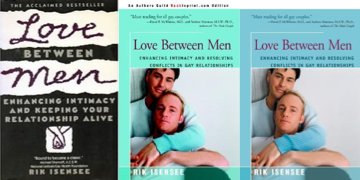
Editions before and after Alyson Books all show unsexualized imagery but still convey a gay couple in the photo. This edition was published by Alyson Books in 2000, only days after the first state (Vermont) legalized partnerships between same-sex couples. The 2000s were a time of acceptance and most importantly, notoriety of same-sex couples. It makes sense for a book like this to highlight the sexual atmosphere of same-sex couples. Alyson Books conveys that it is an intimate book for gay couples, but the question of whether or not its cover is too sexualized is still up for debate. Compared to its heterosexual version and its other editions, I would say that the same message could’ve reached its target audience without revealing as much skin.
Search Results: Cocksure vs Heteronormative Eroticism
Blake Craig
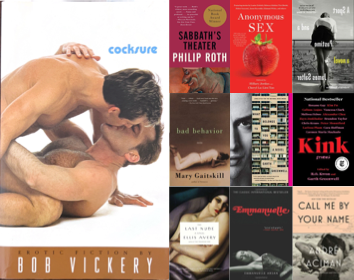
For this comparison, I wanted to look into search engine results of what a user may find and what types of books come up. The book, Cocksure, is a queer, erotic, fiction story that delves into the erotic escapades of John Tremont, a young man navigating the competitive world of advertising in 1960s New York City. The novel explores John's steamy encounters, intimate relationships, and the seductive allure of power and desire in the fast-paced corporate environment. Through its explicit and sensual narrative, Cocksure offers a provocative exploration of lust, ambition, and the interplay between sexuality and success in an era defined by both liberation and restraint.
When initially searching, I looked up “lgbtq erotic fiction” or “queer erotic stories,” something to gather a couple of sources about works of this genre. However, I only found one article that gave descriptions, but no book covers. Confining myself to just search results, I didn’t look further than what was advertised on the link, meaning I didn’t search for pictures of the titles mentioned. I wanted to look at how LGBTQ erotic books were marketed compared to straight erotic books. Beyond that one book, there weren’t any other book sites on the first page of search results. This lack of information is interesting because there are plenty of erotic stories and pages dedicated to the genre, but why not LGBTQ versions? Also, why did the one site I found not list any images of each cover? Were they too sexual to display or is it not worth showing? Many questions came out of why much information isn’t available. It is important to ask these questions as we are establishing an archive focused on LGBTQ books. We want to preserve their importance and continue to make strides to educate the digital community on their existence.
Reviews on Cocksure aren't the greatest, just hovering around 3.56 stars on Goodreads. It is a book where reviewers said “I’m not the target audience” or “Nothing here is all that memorable.” Based on these remarks, this book didn’t advertise well. In correlation with the cover image, could a reason of why it isn’t selling as well be the cover image? It’s suggestive display of two men passion for one another could be unappealing to the common reader. Even straight erotic book covers mainly use symbolism to cast their sexual image. Similar to the reason given in the segment on self-help books, did Bob Vickery have to be clear to his audience that his book was a gay erotic fiction so uninterested readers knew to stay away? It is truly interesting why the illustrators would choose specific images to represent a novel.
Historical context doesn’t play too much into the picture of this book, which was published in 2002. During this time, there was a greater normalization of accepting same-sex relationships. This acceptance is important because it normalizes the viewing of text like Cocksure.

So why aren’t there more articles with displays of gay erotic fiction? Most of the covers I have found include similar images to Cocksure but none are displayed in personal articles. However, using Esquire’s blog about popular straight erotic fiction, it lists images and descriptions of every book mentioned. The other sites below Esquire’s post similarly. Although there is author bias in terms of what they post, I find it interesting that cover images aren’t displayed on gay erotica sites. The book covers are definitely more intimate on gay erotic books, but why does that mean they aren’t displayed?
Using our Alyson Archives site is important to preserving and displaying LGBTQ works because it doesn’t hide or limit the coverage of certain, especially explicit book covers. Other articles don’t show the illustrations which are important to the overall work itself. Having a space to openly display these cover images helps normalize and desensitize viewers to the LGBTQ culture.
Blake's Citations
Alliance, National Cybersecurity. “Data Privacy Is Crucial for the LGBT Community.” National Cybersecurity Alliance, February 20, 2018. https://staysafeonline.org/online-safety-privacy-basics/data-privacy-crucial-lgbt-community/.
“The Sexiest Erotic Novels of All Time." Esquire. July 15, 2022. https://www.esquire.com/entertainment/books/a52988/sexiest-erotic-novels-of-all-time/.
"Meet Your next Favorite Book.” Goodreads. Accessed April 29, 2024. https://www.goodreads.com/?ref=nav_hom.
Lizarraga, Alyssa. “I Judge Books by Their Covers and You Should Too.” LatinaMedia.Co, March 16, 2023. https://latinamedia.co/book-covers/.
“Milestones in the American Gay Rights Movement." PBS. Accessed April 29, 2024. https://www.pbs.org/wgbh/americanexperience/features/stonewall-milestones-american-gay-rights-movement/.
Price, Tirzah. “Out and Proud vs. Hiding in Plain Sight: The Evolution of YA Book Covers.” Book Riot, October 11, 2016. https://bookriot.com/proud-vs-hiding-plain-sight-evolution-ya-book-covers-ncod/
